
Screw Conveyor Machine
Screw conveyor machine is a universal equipment for conveying powder and granular materials horizontally or inclined.
As a commonly used conveying equipment, screw conveyors can complete centralized conveying, separate conveying, mixed materials, mixing, dehydration, customized ingredients, unloading, and stacking, and can be used in conjunction with other conveying equipment.
The versatility and cost effectiveness of the screw conveyor make it a perfect choice for handling a wide variety of bulk materials.
RICHI designs and manufactures screw conveyors to meet the needs of many industries, such as feed, grain, oil processing and warehouse, chemical industry and other industries.
- Model:TLSS
- Capacity: 2-80T/H
Our auger conveyor can be delivered as stand-alone units, as part of complete bulk material handling systems or for transportation of processed wood materials.
types of screw conveyor
Screw conveyors are widely used. The types of screw conveyors we have made so far include the following:
- horizontal screw conveyor
- stainless steel screw conveyor
- double screw conveyor
- cooling screw conveyor
- feed screw conveyor
- paddle screw conveyor
- ribbon screw conveyor
- silo screw conveyor
- mixing screw conveyor
- dosing screw conveyor
- automatic screw conveyor
- weighing screw conveyor
- grain screw conveyor
- ….
Features of screw conveyor machine
The flexible screw conveyor is one of the most reliable and cost-effective ways to material bulk handling. It is a very versatile machine that can handle a wide variety of materials, from dry, free-flowing materials to wet and slow materials.
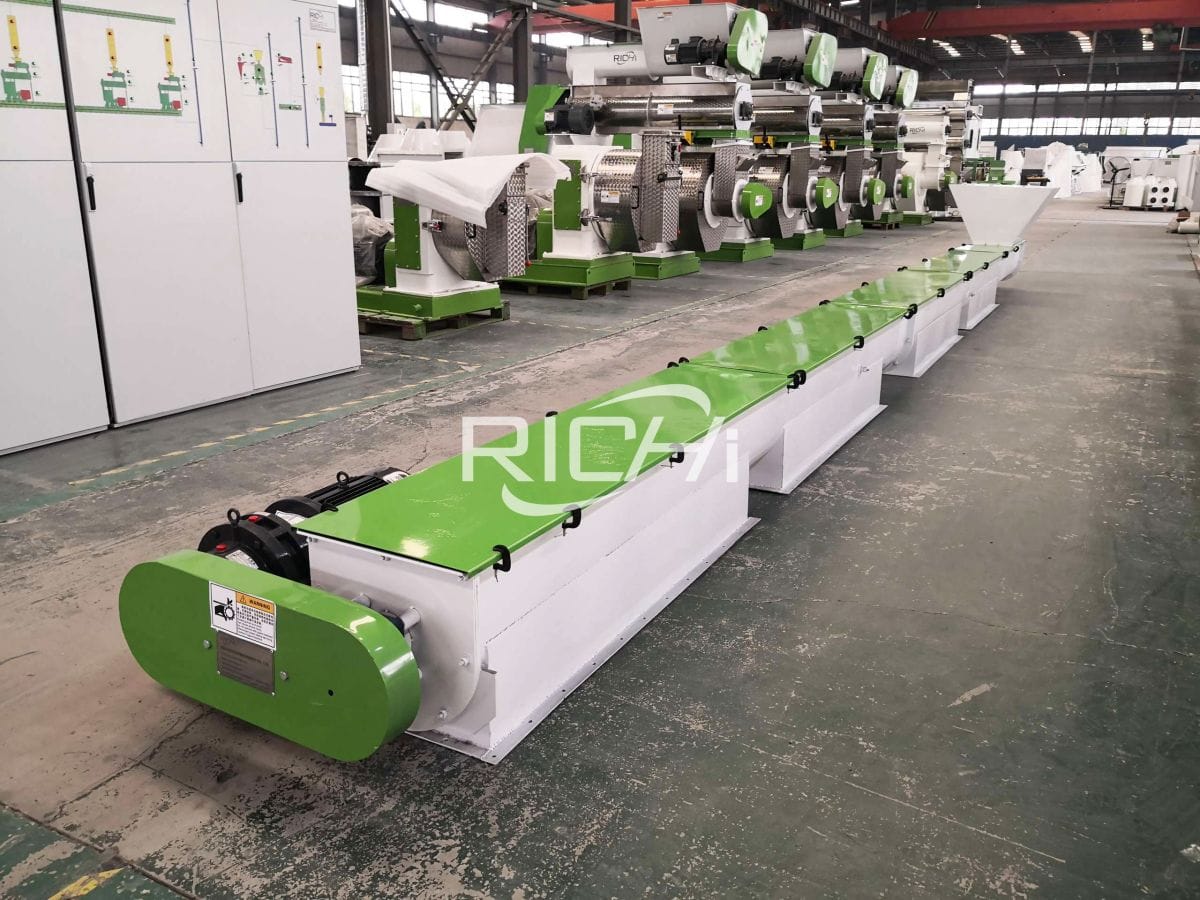


- The auger screw conveyor equipment adopts seamless steel tube, which has higher strength.
- The blade thickness is 1.5mm, which is more wearable and durable.
- Optional anti-blocking and speed-measuring alarm
- Loading capacity is large, safe and reliable.
- Large conveying capacity: Allows transportation of large amounts of materials in a small space, with a conveying capacity of 458m/h and a length of up to 60 meters.
- Conveying uniformly and without jamming: The whole machine is fast, conveys quickly and evenly, and materials are not easily blocked. It can be connected and fixed with other supporting equipment.
- Sealed structure: prevents odors, prevents foreign matter from entering, avoids spills and minimizes maintenance.
- Easy to load and unload: Horizontal screw conveyors can be loaded and unloaded at any point on their conveying line, and vertical screw conveyors have superior feeding capabilities compared to screw feeding devices.
- Flexible layout: It can be installed on elevated, ground or pit, installed horizontally or on a slope (≤15°), and can also be transported vertically upwards.
RICHI Machinery is an ISO and CE certified screw conveyor manufacturer. Every component and assembly is manufactured in China by highly skilled craftsmen. RICHI industrial screw conveyors are manufactured to rigid quality standards.
Technical parameters of screw conveyor machine
The above is an introduction to screw conveyors. Product specifications include (tube type, U-shaped) (single shaft, shaftless), shell blade material: carbon steel, stainless steel.
According to the particle size, transportation volume and transportation distance of the materials to be transported, a reasonable select and design to ensure no clogging, no arching, and smooth material discharging.

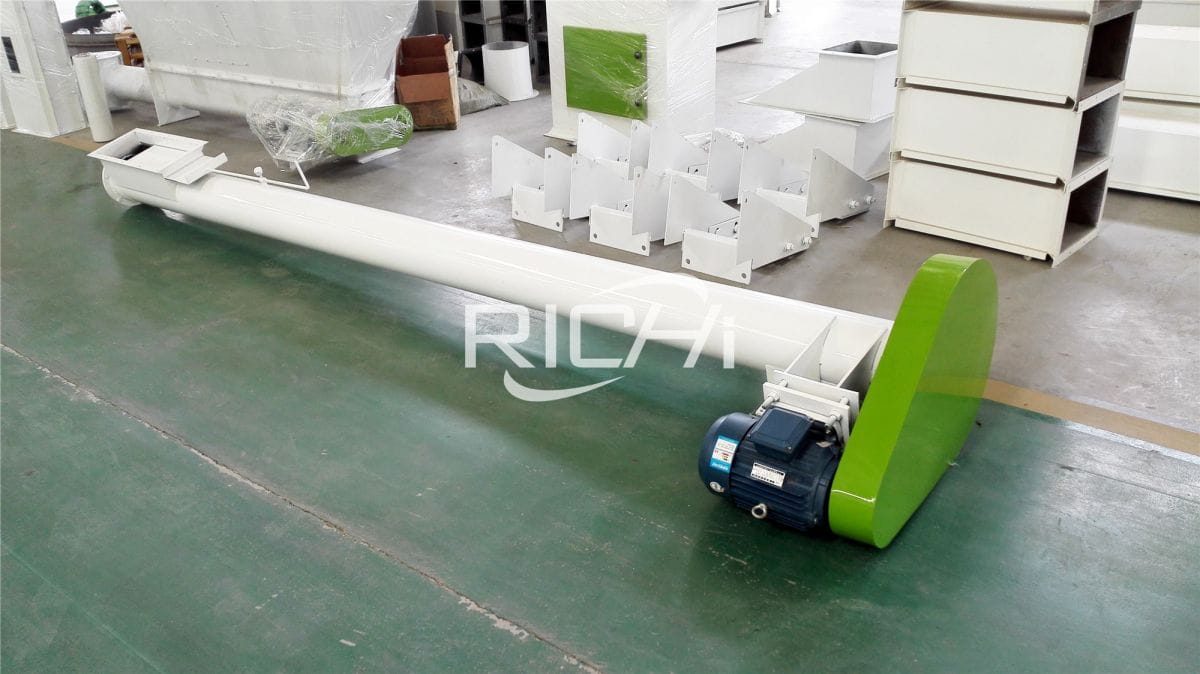
screw conveyor for sale – Round unloading machine
| model | TLSS133 |
| Spiral diameter (m) | 0.133 |
| Rotating speed | 127 |
| Spiral distance | 0.106 |
| coefficient | 0.35 |
| Conveying distance (m) | 1-6 |
| Output (m³/h) | 2-3 |
| Spiral elevator lifting angle | 0-3° |
| Power (kw) | 1.5 |
auger conveyor for sale – U-shaped unloading machine
| model | TLSS12 | TLSS16 | TLSS20 | TLSS25 | TLSS32 |
| Spiral diameter (m) | 0.12 | 0.16 | 0.2 | 0.25 | 0.32 |
| Rotating speed | 127 | 127 | 127 | 127 | 127 |
| Spiral distance | 0.096 | 0.128 | 0.16 | 0.2 | 0.256 |
| coefficient | 0.35 | 0.35 | 0.35 | 0.35 | 0.35 |
| Conveying distance (m) | 1-6 | 1-6 | 1-6 | 1-6 | 1-6 |
| Output (m³/h) | 2-3 | 6-7 | 10-15 | 20-25 | 30-35 |
| Spiral elevator lifting angle | 0-3° | 0-3° | 0-3° | 0-3° | 0-3° |
| Power (kw) | 1.5 | 2.2 | 2.2 | 3 | 4 |
screw conveyor for sale– Spiral elevator
| model | TLSS16 | TLSS25 | TLSS30 |
| Spiral diameter (m) | 0.12 | 0.2 | 0.26 |
| Rotating speed | 127 | 127 | 127 |
| Spiral distance | 0.096 | 0.160 | 0.208 |
| coefficient | 0.35 | 0.35 | 0.35 |
| Conveying distance (m) | 1-6 | 1-6 | 1-6 |
| Output (m³/h) | 3-6 | 10-15 | 20-25 |
| Spiral elevator lifting angle | 0-60° | 0-60° | 0-60° |
| Power (kw) | 2.2 | 2.2 | 3 |
flexible screw conveyor for sale – Closed air screw conveyor
| model | TLSS16 | TLSS20 | TLSS25 |
| Spiral diameter (m) | 0.14 | 0.19 | 0.25 |
| Rotating speed | 127 | 127 | 127 |
| Spiral distance | 0.112 | 0.152 | 0.200 |
| coefficient | 0.35 | 0.35 | 0.35 |
| Conveying distance (m) | 1-6 | 1-6 | 1-6 |
| Output (m³/h) | 3-6 | 10-15 | 20-25 |
| Spiral elevator lifting angle | 0-3° | 0-3° | 0-3° |
| Power (kw) | 1.5 | 2.2 | 2.2 |
In addition to the above parameters, if you have other requirements for the sscrew transporter, for example: the machine requires 304 stainless steel, or requires a universal wheel, a discharge port feed pipe at the bottom, an anti-blocking switch or other special designs, etc., please contact us .
Screw conveyor machine projects

screw conveyor for sale Algeria
- Application: 6-10T/H Poultry Animal Feed Plant

screw conveyor for sale Uzbekistan
- Application: 10-15T/H Chicken Animal Feed mill Plant

screw conveyor for sale Peru
- Application: 5T/H Animal Feed Plant For Poultry Chicken

screw conveyor for sale Malaysia
- Application: 3-5T/H Broiler Feed Plant

flexible screw conveyor for sale Nigeria
- Application: 1-2T/H Poultry Feed Plant

flexible screw conveyor for sale oman
- Application: 15T/H Aqua Poultry Feed Plant
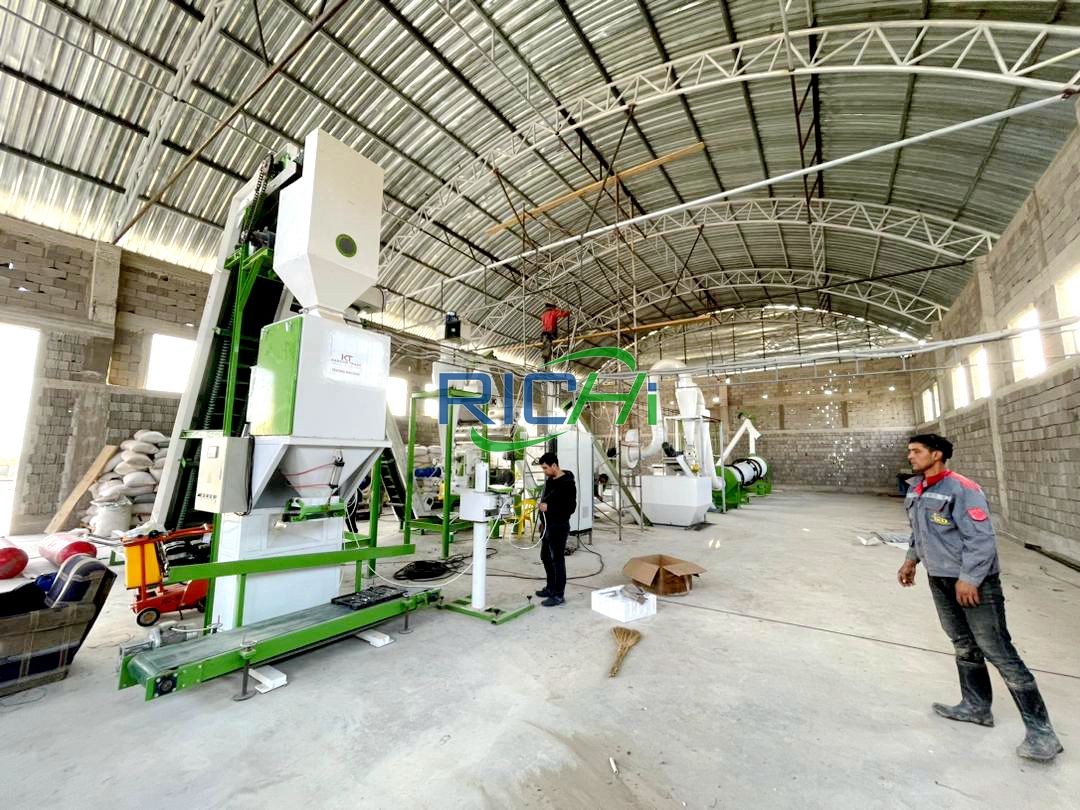
flexible screw conveyor for sale Russia
- Application: 5-7 T/H Poultry Chicken Feed Plant
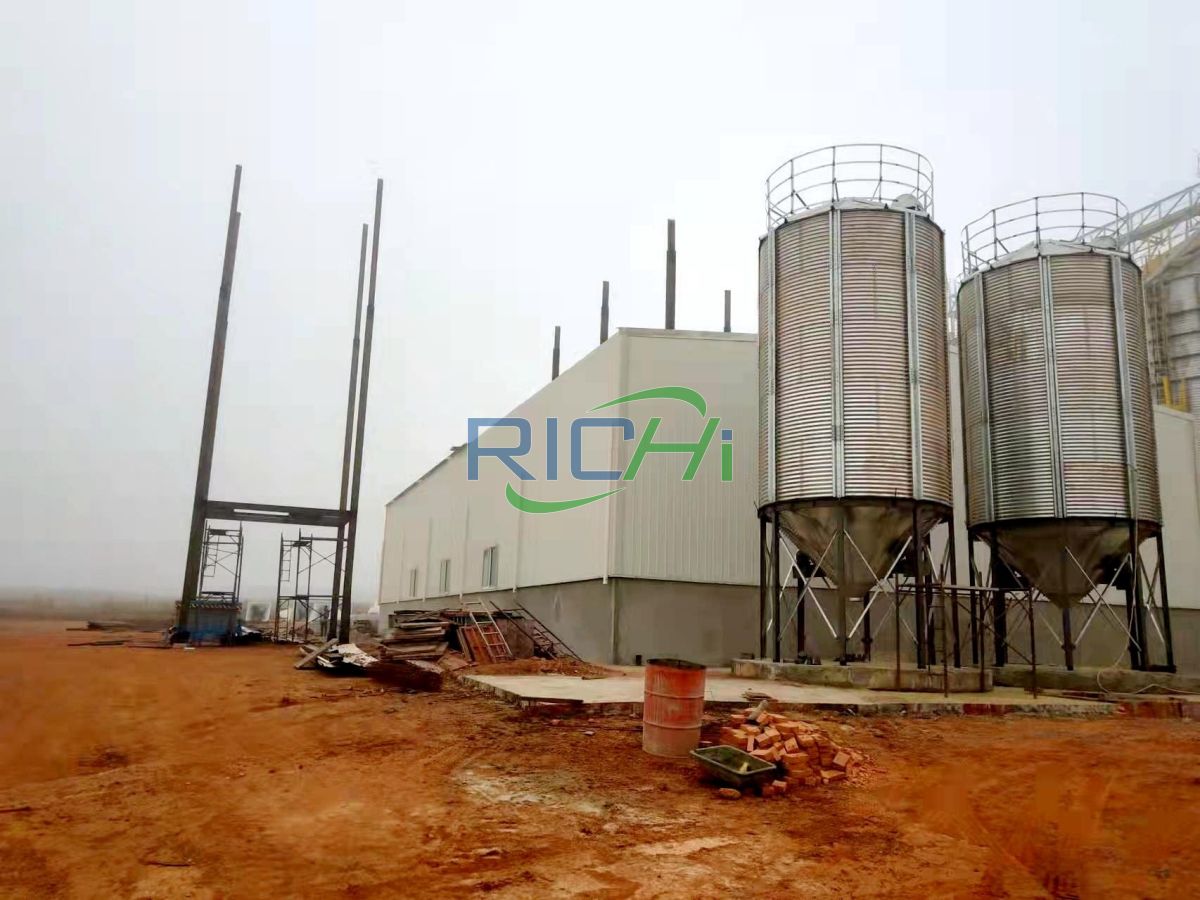
flexible screw conveyor for sale Angola
- Application: 10T/H Poultry Pellet Plant
Application of screw conveyor machine
Automatic screw conveyors are used to handle any type of bulk material and are found in thousands of applications.
(1) For different industries:
The main industries that use screw conveyors are:
- Feed production
- Chemicals Food processing
- Wood and wood products
- Mining and Minerals
- Processing Oil and gas extraction
- Oil refining
- Primary metals
- Pulp and paper Rubber and Plastics Stone, glass and concrete
- Environmental
- …
(2) Handling capabilities
In general most free flowing powders, grains and pellets, as well as many semi-free flowing materials, can be conveyed or discharged with RICHI screw system.
The specification standard is also easily tailored to suit:
- Abrasive materials
- Damp, wet or sticky materials
- Materials prone to fluidisation
- Greasy, oily products
- Hot, cold, wet or aggressive environments
- …
Utilizing one robust moving part, screw conveyor machiners are an elegantly simple way for transferring flowable bulk materials horizontally or vertically. RICHI utilizes the most robust construction and components in the industry to ensure the reliability and durability of our screw conveyors.
How to choose a suitable screw conveyor machine?
How to choose a suitable screw conveyor is what many customers want when purchasing. Most screw conveyors are non-standard products, so when customers purchase, manufacturers will ask customers to provide detailed parameters so that they can design a screw conveyor suitable for the customer.
So when customers make a purchase, how can they know whether it is suitable for them?
In order to purchase a suitable screw conveyor, buyers need to provide some accurate conveying requirements and physical property data, including hourly conveying volume of materials, lifting height, conveying distance, material name, density, adhesion, corrosiveness, particle size, shape, etc. And whether the delivery volume is constant.
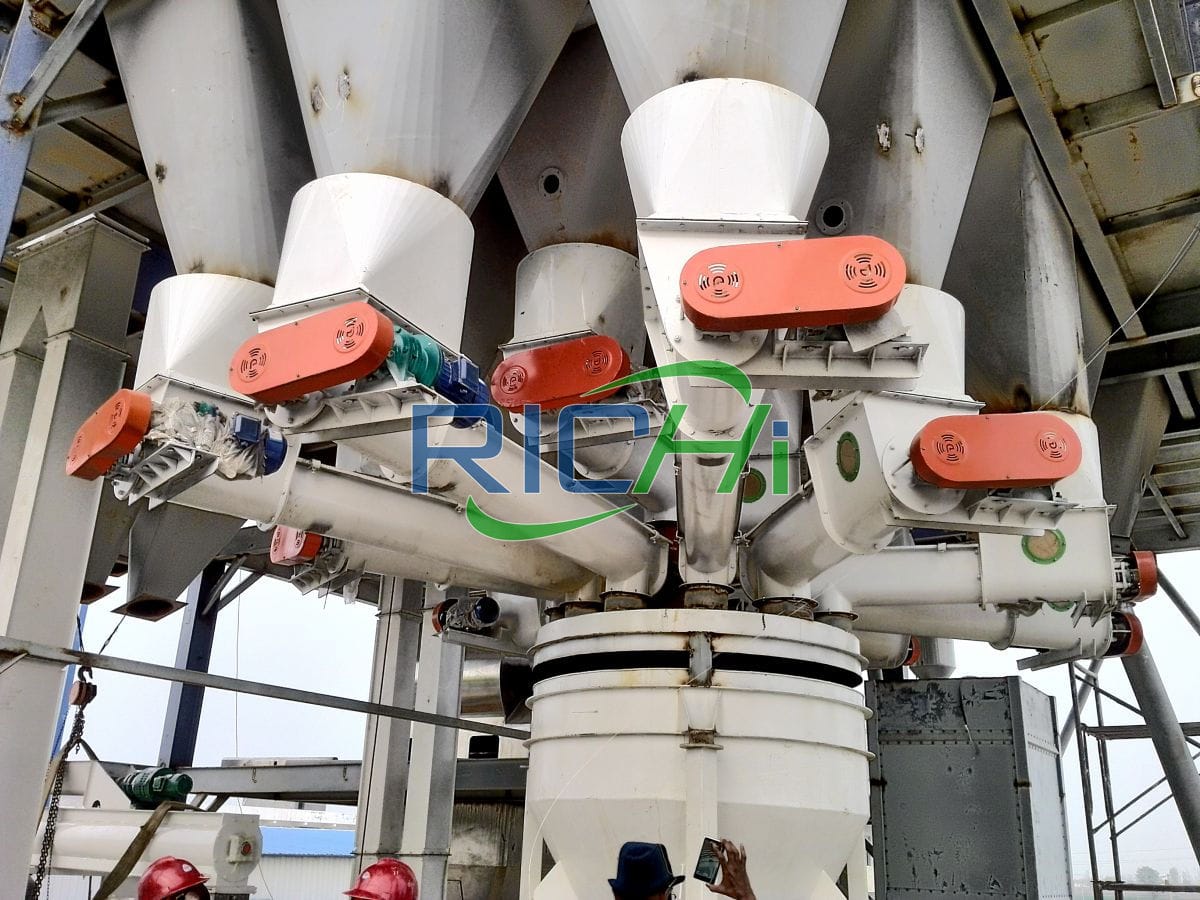
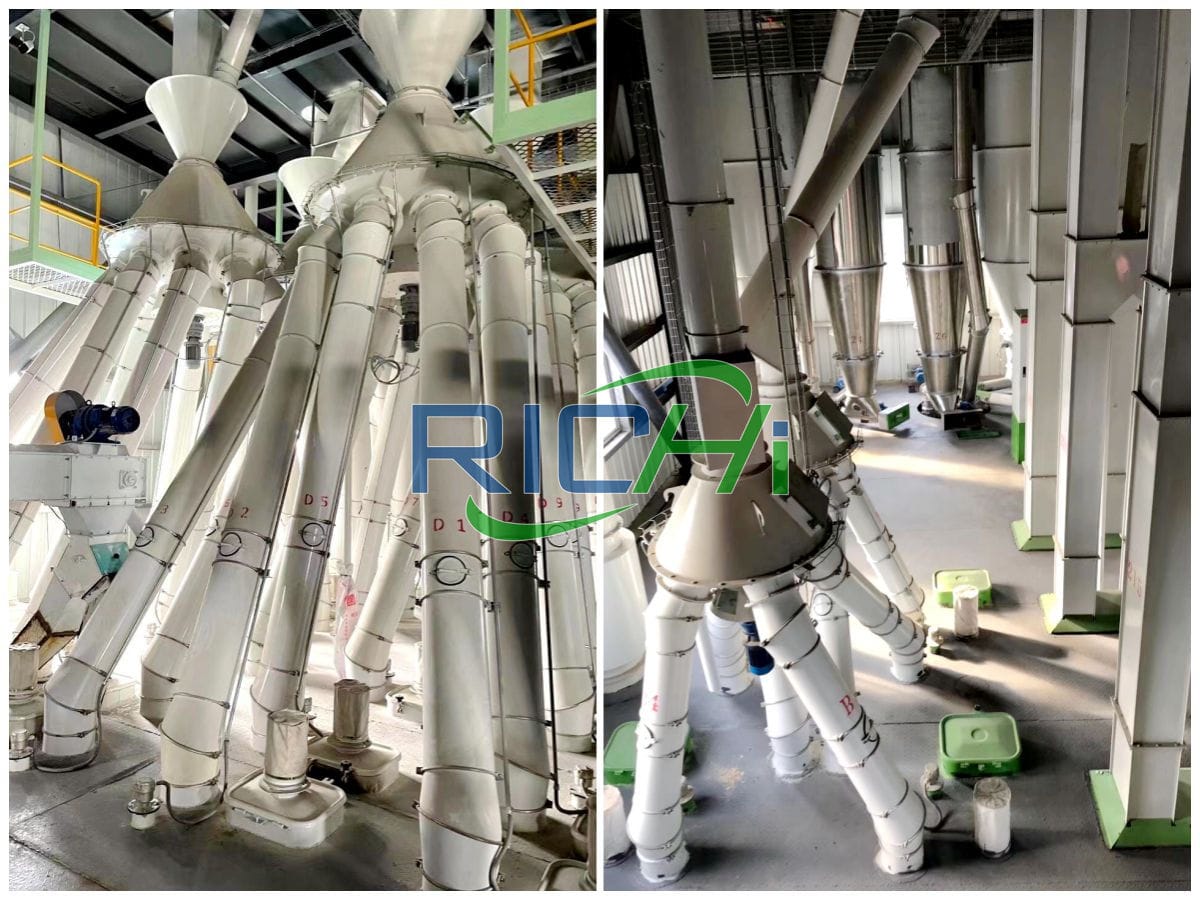
When selecting a screw conveyor, you need to consider:
- Nature of materials
- Transportation volume requirements
- The conveying length and angle of the equipment
- Equipment structure and materials
- The conveying speed and rotation speed of the equipment
- Chain selection of equipment
- Material handling requirements
- Noise and energy consumption of equipment
- Self-cleaning of equipment
- Equipment reliability and lifespan
- Ancillary facilities of equipment
- . . .
1. Nature of materials
First, you need to understand the properties of the materials to be transported, including particle size, density, humidity, fluidity, etc. These factors will directly affect the selection and use of screw conveyors.
2. Conveying volume requirements
Select the appropriate screw conveyor according to the actual conveying volume requirements. Generally speaking, the greater the conveying volume, the larger the equipment required and the higher the power.
3. The conveying length and angle
The conveying length and conveying angle of the screw conveyor machine have a great influence on the use effect and conveying capacity of the equipment. It is necessary to select the appropriate conveying length and angle according to actual needs, and pay attention to the maximum conveying length and maximum conveying angle of the equipment to ensure the normal operation and safety of the equipment.
4. Equipment structure and materials
The structure and material of the screw conveyor machiner have a great impact on the life and use effect of the equipment. The material selection of screw conveyors needs to consider many factors, including the chemical composition, temperature, humidity, etc. of the conveyed materials.
Generally speaking, for materials that are prone to corrosion or materials that require high or low temperature environments, materials with strong corrosion resistance or high and low temperature resistance need to be selected, such as stainless steel, alloy steel, etc.
At the same time, it is also necessary to consider whether the structural design of the equipment is reasonable to facilitate cleaning and maintenance.


5. Conveying speed and rotation speed
The conveying speed and rotation speed of the screw conveyor machine have a great impact on the use effect and safety of the equipment.
It is necessary to select the appropriate conveying speed and rotation speed according to the nature of the material and the transportation volume requirements, and pay attention to controlling the maximum rotation speed of the equipment to ensure the normal operation and safety of the equipment.
6. Equipment chain selection
For auger conveyors using chain drive, chain selection is also very important.
Generally speaking, factors such as the strength, wear resistance, and corrosion resistance of the chain need to be considered, and the specifications and models of the chain should be reasonably selected based on actual needs.
In addition, the chain needs to be kept well lubricated to extend its service life.
7. Material handling requirements
Different materials may have different requirements when processing, such as viscosity, fragility, caking, etc.
It is necessary to select a auger conveyor that meets the characteristics of the material according to the actual requirements, and carry out corresponding processing measures to ensure the normal transportation of the equipment.
8. Equipment noise and energy consumption
The noise and energy consumption of the equipment are also factors that need to be considered when selecting. It is necessary to choose equipment with low noise and low energy consumption to improve the efficiency and comfort of use of the equipment.
9. Self-cleaning
The self-cleaning property of the screw conveyor system refers to whether the residual materials inside the equipment will affect the operation of the equipment. It is necessary to choose equipment with good self-cleaning properties and strengthen cleaning and maintenance work to avoid damage to the equipment from impurities inside the equipment.
10. Equipment reliability and lifespan
The reliability and lifespan of screw conveyors have a great impact on equipment investment and subsequent maintenance. It is necessary to choose equipment with good reputation and quality assurance, and carry out regular inspection, maintenance and replacement of parts according to the use of the equipment to extend the service life of the equipment.
11. Ancillary facilities
Equipment ancillary facilities include motors, reducers, bearings and other components, which have a great impact on the operational stability and life of the equipment. Quality ancillary facilities need to be selected and properly installed and maintained.
In short, the selection of screw conveyor machine needs to be based on actual needs and material characteristics, and factors such as the conveying length and angle of the equipment, material handling requirements, self-cleaning performance, reliability and lifespan should be considered.
Only by selecting appropriate equipment and performing correct installation and operation can the normal operation and service life of the equipment be ensured.
Why choose Richi Machinery?

Identifying the right screw conveyor supplier for a job can be a daunting task. To narrow the potential suppliers, consider the following factors:
- Flexibility: Make sure the screw conveyor manufacturer is prepared to tailor the unit to the specific requirements of the material being handled, as well as any operational goals. This will ensure an efficient and reliable handling solution with long-term dependability.
- Material Experience: Many screw conveyor suppliers specialize in a specific industry. In choosing a manufacturer, ensure they have experience around the unique challenges of the material to be handled.
- Quality: Screw conveyor machines must be manufactured according to high quality standards for a low-maintenance, reliable handling solution.
- Aftermarket Support: Select a screw conveyor manufacturer that has the capabilities to service and maintain their equipment for a maximum return on investment. This includes provision of spare parts, training, installation assistance, and more.
For more information about screw conveyor, feel free to contact Richi Machinery! (Find us on YouTube)
FAQs of screw conveyor machine

How does the screw conveyor machine work?

The flexible screw conveyor is a typical conveying equipment with a spiral shape. A spiral is a screw-like part with enlarged threads that may or may not have a center.
After the screw of the screw conveyor is connected to the motor, both ends of the screw are generally supported by bearings. The torque of the motor is transmitted to the screw through the coupling connection to drive the screw to rotate.
A tubular or U-shaped groove is used around the spiral as a conveying restriction surface to form a trough. Powdered, granular or even stagnant materials are pushed forward along the groove surface.
The material trough can be covered or not covered. Covering can make the material conveying process cleaner and more closed.
The material first passes through the inlet of the screw conveyor, then through the rotating screw, and finally is discharged from the discharge end.
Depending on the purpose, screw conveyors can be installed horizontally, vertically or inclined. The screw conveyor has a simple structure and is widely used. In addition to conveying sheet, powder, granular, and strip materials, it can also be used as a filling system conveyor.
Small conveyors are mainly used to transport cement and non-flowing media, while large conveyors are mainly used as agricultural harvesters.

What does the spiral diameter of a screw conveyor machine mean?
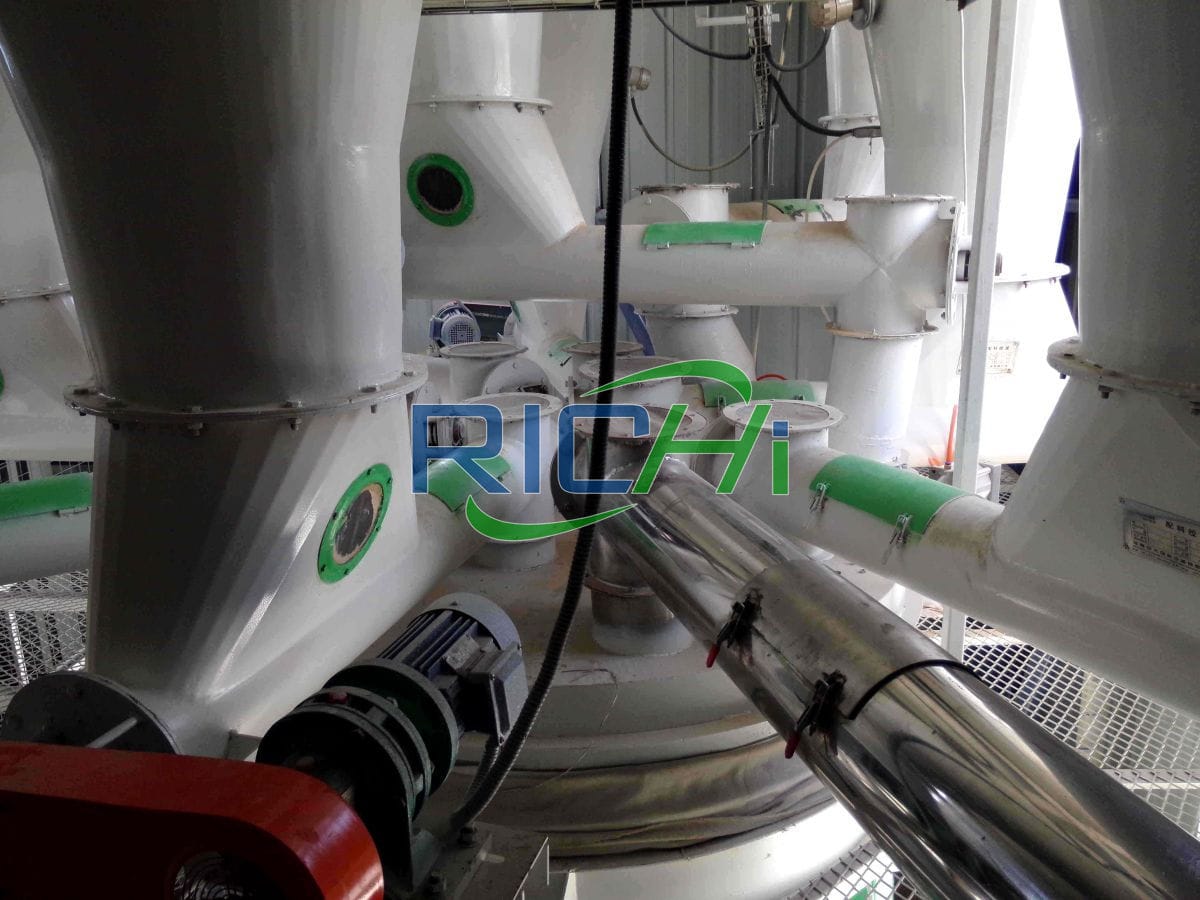
In screw conveyors, the screw diameter is a very important parameter, which directly affects the performance and conveying capacity of the conveyor. So, what exactly does the spiral diameter of a screw conveyor refer to?
The spiral diameter of the auger screw conveyor refers to the diameter inside the spiral tube. It is one of the important indicators to measure the size and conveying capacity of the screw conveyor.
Generally speaking, the larger the spiral diameter, the stronger the conveyor’s conveying capacity and the more materials it can withstand.
The size of the spiral diameter not only affects the conveying capacity and efficiency of the conveyor, but also affects the rotation speed and torque of the equipment.
Under the same length and pitch, the larger the spiral diameter, the greater the speed and torque of the equipment, and the more materials it can withstand.
In addition, the size of the spiral diameter is also related to the manufacturing and design of the equipment. Different manufacturers and different models of screw conveyors may have different screw diameters.
Therefore, when selecting a screw conveyor, it is necessary to select the appropriate model and specification based on actual needs and production requirements.

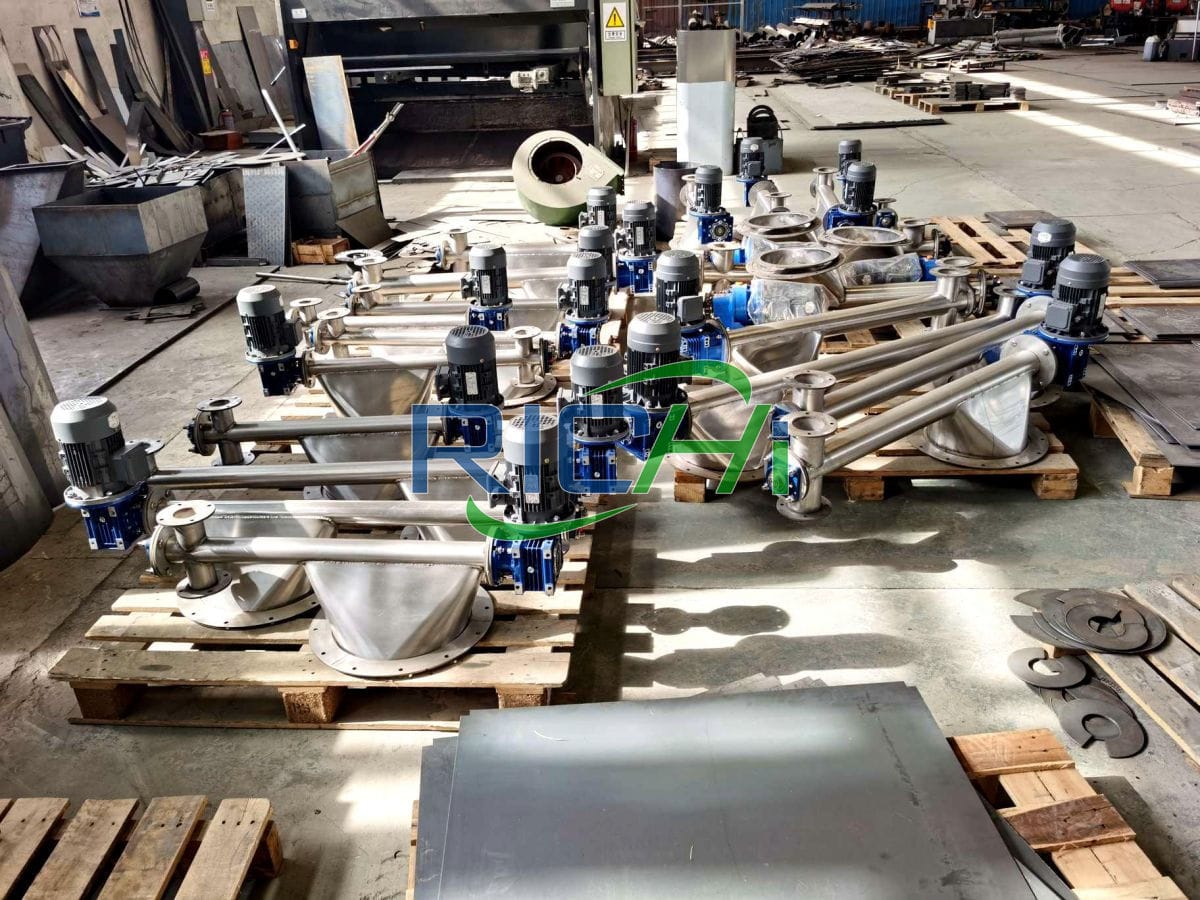
In short, the spiral diameter of a screw conveyor is one of the important indicators to measure its size and conveying capacity. It not only affects the performance and efficiency of the equipment, but is also closely related to the manufacturing and design of the equipment.
Therefore, when selecting and using screw transporters, you need to select and design according to actual needs and production requirements to ensure that the equipment can meet production requirements and process requirements.
If you have any questions, please leave a message to discuss! (Maybe you are interested in our bucket elevators)

What types of screw conveyors are there?
Screw conveyors can be divided into the following types:
(1) Horizontal screw conveyor machine
The horizontal screw conveyor is the most widely used product among screw conveyors. It is designed to be simple and easy to use and is mainly used in process production.
In some horizontal conveyor designs, other types of conveying features are added to meet usage requirements. The horizontal screw conveyor can transport materials at a filling rate of 15%~45%.
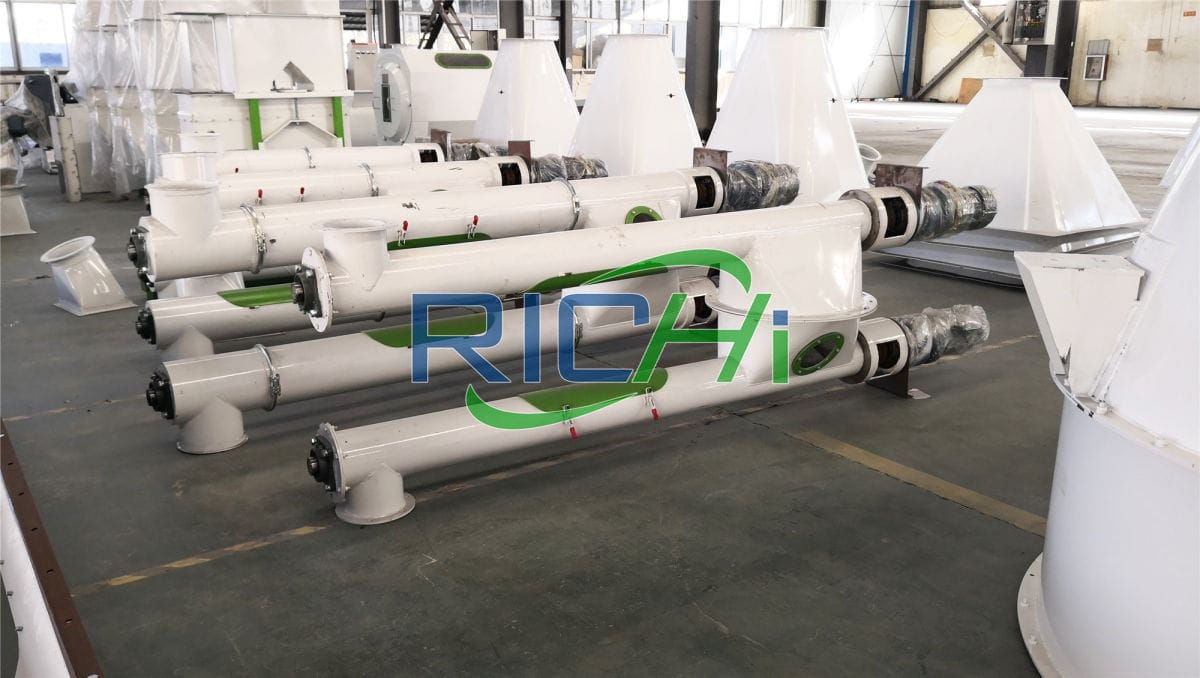
The filling rate refers to the percentage of the tank space occupied by the material to the total space of the tank under a given conveying volume.
For materials that are highly viscous and difficult to flow, a lower filling rate can be used; for media with smaller density and good free-flowing properties, a higher filling rate can be used.
For free-flowing and non-flowing media, screw conveyors are a cost-effective and cost-effective option, second only to traditional belt conveyors. Screw conveyors are also ideal for conveying mixtures of materials.
Depending on the environment, the trough can be open, partially open, or completely closed.
(2) Inclined screw conveyor machine

Inclined screw conveyors function the same as most conveyors, but are arranged at an incline between 0° and 45°.
However, the material conveying process of the inclined screw conveyor is quite different, because the inclined arrangement will reduce the conveying efficiency and the amount of material passing through the screw.
And a wider torque is required to push the material through the conveyor, so more stringent product design requirements must be put forward, Improve conveying efficiency.
The lean angle should be as small as possible to maximize efficiency and reduce the additional power required.
- An inclination angle less than 10° has the least impact on efficiency, and the decrease in conveying efficiency can be compensated for by accelerating the rotation speed.
- An inclination angle of 10°~20° will reduce the spiral efficiency by 10%~40%, which requires a significant increase in power to compensate, thereby reducing efficiency. If the angle exceeds 20°, the efficiency will be reduced by 30% to 90%.
The efficiency mainly depends on the angle. As the angle increases, the spiral efficiency decreases and the power requirement increases significantly.
Inclined at an angle of 10° or greater, the entire spiral will be conveyed under variable cross-section filling rate conditions. that is, part of the material will fall back to the lower end of the conveyor during the conveying process, reaching 100% filling rate at the lowest point.
Inclined screw conveyors are commonly used in cement mixers, feed distribution, sugar and meat processing production.
(3) Shaftless screw conveyor machine
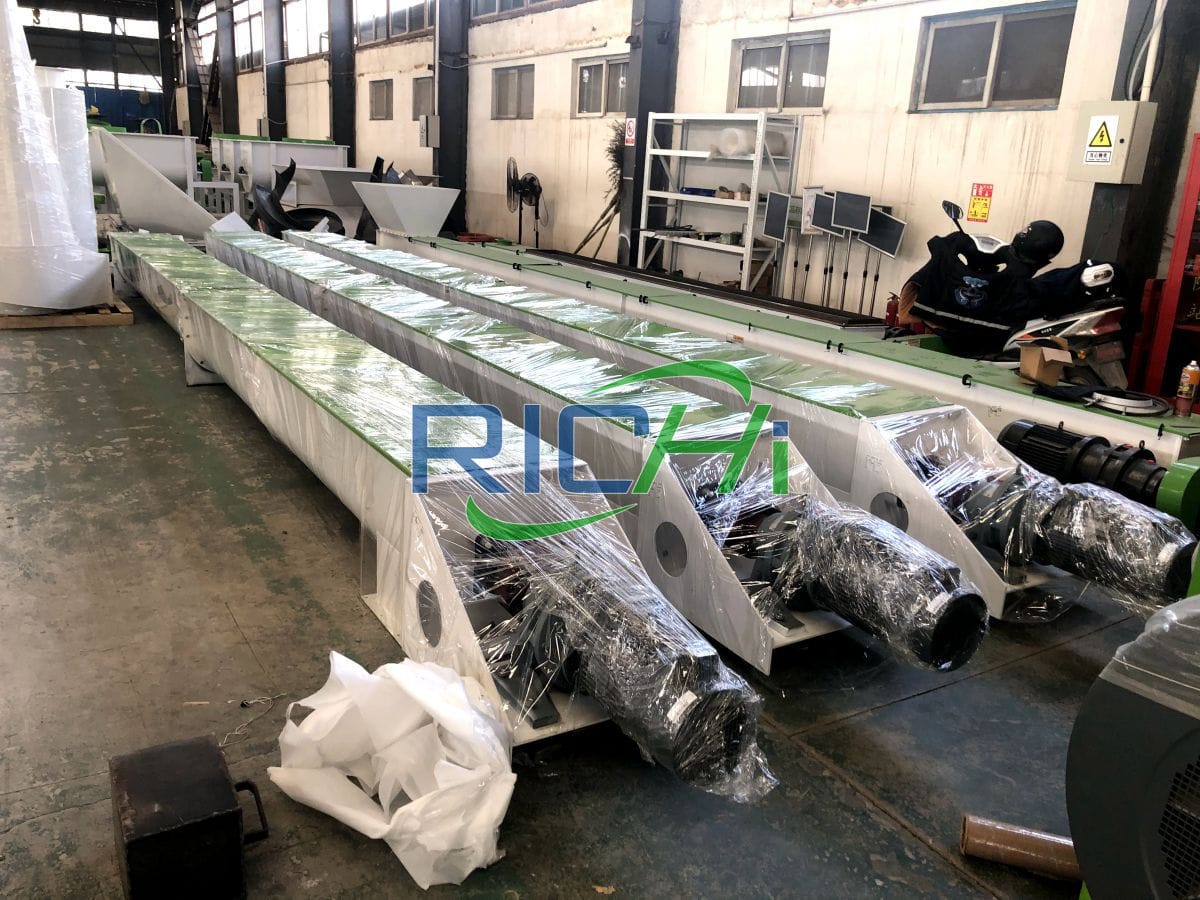
The shaftless screw conveyor has an improved design on the spiral of the traditional screw conveyor. The shaftless spiral allows the medium to flow through the center of the spiral and around it.
It seems like a small change, but it makes a huge difference in use because it improves the efficiency and flexibility of the screw conveyor expand the range of media that can be transported.
Theoretically, this type of equipment is impossible to clog and can convey materials that normally cannot be handled by auger screw conveyors, such as wet or non-flowing products.
The conveying efficiency is higher than other conveyors, even higher than conveyor belts, and does not require internal traditional bearing design.
Such equipment is frequently used in food, chemical, wastewater, mining and other important industries.
(4) Vertical screw conveyor machine
Vertical screw conveyors can transport large quantities of bulk products, including all screw conveyors with an inclination angle greater than 45°. They are mainly used for dry or semi-dry materials and occupy very little space.

The feeding method of the conveyor depends to a large extent on the materials being transported. Light materials cannot use gravity hoppers alone, so spiral blades are used to blow the materials and provide material flow power.
Therefore, vertical auger conveyors are often equipped with this blade design to regulate the feed flow rate and ensure that the material enters the conveyor evenly.
At the same time, the vertical spiral is kept running at a constant speed, improving efficiency and reducing power consumption.
The most common areas of application for vertical screw conveyors are chemical, food and mining operations.

If I want to customize a screw conveyor, how can you customize the design for me?
As mentioned above, our products are basically customized. RICHI screw conveyor machines provide an economical way to elevate and move your products.

We design our equipment based upon the production needs and specific requirements that clients share during our complimentary pre-engineering process.
However, most screw conveyor manufacturers have problems with the selection and design of screw conveyors, causing problems such as blockage, rapid wear and low equipment efficiency during use of the conveying equipment.
Many manufacturers lack a basic understanding of the fluidity and details of materials in screw conveyors.
They believe that the material movement process is very simple, and they do not need rich theoretical knowledge to design and produce efficient screw conveyors.
This leads to the eventual failure of screw conveyors. The root cause of failure to meet usage requirements.
- For RICHI engineers, before designing a screw conveyor machine, designers need to understand some properties of the material.
These physical parameters will determine the transmission efficiency of the material in the conveyor and provide designers with a basis for selecting the internal structure and materials of the conveyor. - Physical parameters include material viscosity, particle size, material corrosiveness, whether the material is bonded and hardened during transportation, flammability, explosiveness, whether static electricity is generated, and material fluidity.
You can use a simple method to test the fluidity. Place the material on a stainless steel plate, and then try to push the material forward. By judging whether the material is easy to run and whether there is bonding, you can initially test the fluidity and viscosity of the material.
Only by basically mastering these physical parameters can we ensure that the conveyor produced can be efficient, and transport materials reliably. - Calculate the required volumetric conveyance per hour based on the mass conveyance provided by the user, select the recommended fill rate using the conveyor, select the correct spiral diameter, and determine the rated speed of the conveyor.
The maximum conveying capacity is usually related to the diameter of each screw, and is also affected by the type and size of the screw pitch and the nature of the material being transported. - The diameter of the material particles determines the diameter of the screw conveyor, because the material particles must be able to pass through the blades and trough.
Larger particles require a larger screw conveyor diameter, and smaller particles can use a smaller diameter screw conveyor machine. - Particle size is determined by the maximum size of the largest chunk or piece of material being conveyed. When measuring particle size, find the largest block or piece and measure the largest outline size.
If the particle shape is irregular (for example, one side is larger than the other), choose the larger of the two when measuring. - The characteristics of the material must also be considered. Some materials have hard lumps that will not break during transportation.
Some materials have fairly hard components but break into pieces when conveyed. Knowing this helps designers better size spirals.
The density of conveyed materials is mainly used to determine the conveying capacity of the screw conveyor. The conveying capacity of the screw conveyor is calculated as the volume of m3/h. - The conveying volume that most users need is mass conveying volume. What RICHI designers need is volume conveying volume. Therefore, designers need to convert the mass conveying volume into volume conveying volume.
- Therefore, accurate density is crucial to determine the conveying volume of the screw conveyor machine, otherwise, the problem of insufficient equipment transportation capacity may occur after arriving at the site.
- Designers also need to know how far the material has traveled to determine the length and form of the spiral. The more accurate the data provided by the user, the simpler the installation steps for the device will be.
- Data such as how the screw conveyor feeds and discharges materials, at what height it feeds, the size and height of the feed hopper, the size and form of the discharge chute, etc. are also very important to the design of the screw conveyor.
- In addition to the above factors, there are some other factors, including the discharge position of the screw conveyor, whether a chute or diversion valve needs to be installed at the material outlet, hopper type, cover plate form, insulation requirements, shaft or shaftless design, whether need for heating or cooling jackets, etc., these issues need to be considered before designing in order to design a well-operating screw conveyor machine.
The selection and design of screw conveyors is an extremely complex task.
It requires in-depth communication and multiple rounds of coordination between users and us, so that RICHI’s professional engineers can understand the user’s needs and material properties as detailed and in-depth as possible, and ultimately provide users with satisfactory screw conveyor machine products.